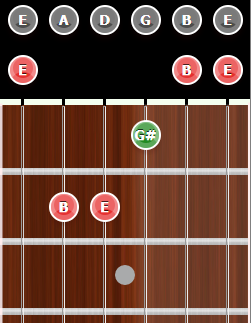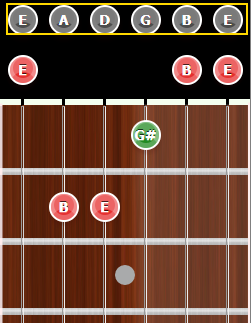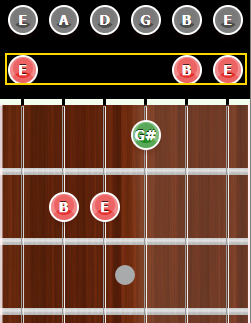Chords
Chords are notes (or tones) that you play simultaneously, that compliment each other and create a full sound.
Most chords consist of 3 or more notes.
Open Chords
The term "Open Chord" means a chord that contains open strings. In standard tuning, the open strings are EADGBe.
There is a formula that is used to create chords, but we'll discuss chord formulas in another lesson.
There are a ton of chord types, but the most common and also the building blocks for all other chords are Major and Minor chords.
The Major and Minor chords have different characteristics.
Any Major chord sounds bright and happy.
Any Minor chord has a sad or meloncoly sound.
One of the first chords that everyone learns is the open E (Major) chord, shown below.

Reading these chord charts
On the top of the graphic, it shows the open notes of the guitar, in this case, Standard Tuning EADGBe in
These are greyed out, in hopes you don't get confused with the notes you should play.

Under the greyed out notes, you see the low E, B and high E. Those are the open notes that you play in the chord.

Next are the fretted notes of the chord.

In the open E (Major) chord, there are 3 fretted notes.
The most common way that these are fretted is your index finger on the G string, first fret.
Your ring finger on the D string, second fret.
You middle finger on the A string, second fret.
Practicing Chords
When you fret any note, you should have your finger as close to the fret as you can.
This ensures that you will be playing that note cleanly, meaning it will ring out.
If the note buzzes, or has a percussive sound, try moving your fretting finger closer to the fret and try again.
When praticing a chord, you should play it 2 ways:
Strum all strings at once. In this case, start at the 6th string, and strum them all.
The most important part is to make sure you are playing the chord cleanly.
One way to test this, is to play each string individually.
If they all ring out and are clear, you're playing it right.
If not, it's either you're not fretting the note close to the fret, or the string is hitting one of your fretting fingers.
Adjust and try again.
Once you are able to play the chord cleanly, practice getting in and out of that chord formation.
For example, play the E (Major) chord. Then move your fretting hand somewhere else, and play random notes.
Then come back to the E chord.
This will help you get the muscle memory programmed into your hands.
Over time, you wont even have to think about where your fingers should go.
The muscle memory will know exactly where to go. It's going to take some practice, but if you put in the effort, it will happen.